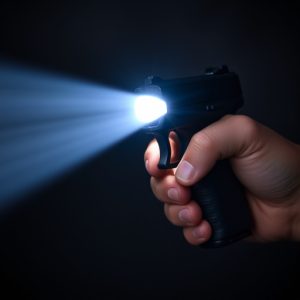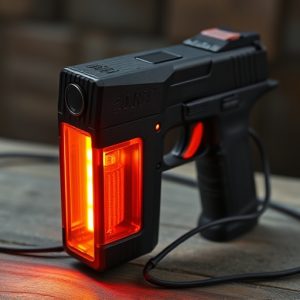Runt Stun Gun Guide: Self-Defense Essentials and Legal Boundaries
The Runt Stun Gun is a compact and effective self-defense tool, small enough for keychains or pocke…….
The Runt Stun Gun is a compact and effective self-defense tool, small enough for keychains or pockets, capable of delivering high-voltage, low-ampere electrical shocks to deter attackers. It features a discreet design, simple operation, and an integrated LED flashlight that improves visibility and acts as a deterrent. Users must be knowledgeable about its functions, maintenance requirements, and the specific legal restrictions governing stun guns in their area because the laws vary significantly across different jurisdictions within the United States. At the federal level, stun guns are classified as firearms under the National Firearms Act of 1934, necessitating careful registration and transfer procedures. On a state level, regulations can range from outright bans in places like Massachusetts and Rhode Island to permissive ownership with strict registration conditions, as seen in Florida. The legal landscape is dynamic, influenced by technological advancements and societal shifts, thus individuals must stay informed about the laws applicable to their locality to ensure compliance and avoid legal penalties. Understanding the Runt Stun Gun within the context of personal safety and legal requirements is essential for anyone considering it as part of their security measures.
When it comes to personal safety, a reliable self-defense tool can be a game-changer. Among the options available, the Runt Stun Gun emerges as a compact yet powerful choice for those seeking an effective deterrent. This article delves into the intricacies of the Runt Stun Gun, offering a guide tailored for self-defense enthusiasts. We will navigate through its legal standing, explore top models in the market, and discuss safety measures for their use. Additionally, we’ll provide insights on selecting the ideal Runt Stun Gun, maintaining it, and understanding how they differ from larger stun gun models. Expert opinions and real-life scenarios highlight the practicality of these devices. Whether you’re a first-time buyer or an experienced self-defense advocate, this comprehensive guide will equip you with the knowledge to harness the full potential of a Runt Stun Gun for your protection.
Understanding the Runt Stun Gun: A Comprehensive Guide for Self-Defense Enthusiasts
The Runt Stun Gun is a self-defense tool that packs a powerful punch despite its compact size, making it an ideal choice for those who prioritize portability and ease of use. This device is designed for individuals who are looking for a non-lethal means of protection that can be effortlessly carried on a keychain or kept discreetly in a purse or pocket. Its diminutive stature belies the potent electrical charges it delivers, which are sufficient to incapacitate an attacker long enough for you to escape to safety.
For self-defense enthusiasts, understanding the Runt Stun Gun’s capabilities and limitations is crucial. It operates by emitting a high-voltage, low-ampere electrical shock that overrides the motor functions of an assailant. This stun gun is legal in many jurisdictions where conventional firearms are not, offering a viable alternative for those restricted by laws or personal beliefs from owning guns. The Runt Stun Gun’s effectiveness lies in its simplicity; it requires minimal training to operate, and its bright LED flashlight can also serve as a deterrent or for situational awareness at night. When considering the Runt Stun Gun as part of your self-defense strategy, it’s important to familiarize yourself with its proper use, maintenance, and legal considerations specific to your locale.
Legal Considerations and Regulatory Framework Governing Stun Guns in Different Jurisdictions
In various jurisdictions, the legal landscape surrounding stun guns, including a ‘runt stun gun,’ is characterized by a complex array of laws that govern their possession, use, and sale. These devices, designed to incapacitate an attacker through an electric shock, are subject to stringent regulations due to their potential for misuse. At the federal level in the United States, stun guns fall under the purview of the National Firearms Act of 1934 and are classified as ‘firearms,’ necessitating a rigorous registration process and transfer requirements. However, individual states may have distinct laws; some may permit their use for self-defense, while others restrict or completely ban them. For instance, states like Massachusetts and Rhode Island prohibit the civilian ownership of stun guns altogether, whereas in states like Florida, there are specific laws allowing for their legal possession with proper registration.
Furthermore, the regulatory framework is not static; it evolves as new technologies emerge and societal attitudes shift. A ‘runt stun gun’ might be categorized differently than traditional stun weapons, depending on its design, capabilities, and intended use. Prospective owners must thoroughly research the laws within their specific jurisdiction to ensure compliance with local, state, and federal regulations. It is imperative to recognize that the legal status of a stun gun can vary significantly from one region to another, making it essential for individuals to stay informed about these dynamic laws. Non-compliance can lead to serious legal consequences, including fines and imprisonment. As such, potential owners must navigate this intricate web of regulations with caution and due diligence.


